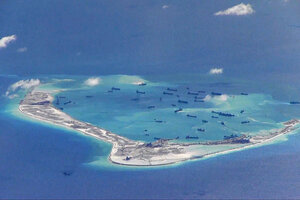China plans blunt move into 'open seas,' warns foreign powers not to meddle
In a new strategy unveiled today, the South China Sea continues to be a potential flashpoint for China and its neighbors, and between Washington and Beijing.

Chinese dredging vessels are purportedly seen in the waters around Mischief Reef in the disputed Spratly Islands in the South China Sea, in this still image from video taken by a P-8A Poseidon surveillance aircraft and provided by the United States Navy on May 21, 2015.
Courtesy of U.S. Navy/Reuters
China outlined on Tuesday a strategy to expand the reach of its military, as it continues to press its territorial claims in the South China Sea. The strategy came amid a series of louder warnings to the United States to divert its military presence in the area.
The Chinese Navy will shift its focus to "open seas protection" rather than "offshore waters defense" alone, according to a policy document issued by the State Council, China’s government cabinet. Meanwhile, China's air force will shift its focus from territorial air defense to "both defense and offense.”
The new plan threatens to escalate tensions in a region already closely watching the extent of Beijing’s maritime ambitions. The State Council criticized neighboring countries that take “proactive actions” on reefs and islands claimed by China.
While the document highlights four key areas of China's national security – the ocean, outer space, nuclear force, and cyber space – its naval strategy carries the greater sting, given its recent activity in the South China Sea. Satellite images released last month show the construction of a runway on Fiery Cross Reef, part of the Spratly Islands, an archipelago claimed by at least three other countries.
China building islands and bases
The construction on Fiery Cross Reef is part of a larger Chinese reclamation project on at least five islands in the South China Sea, reports The New York Times. China is converting tiny reefs into islands big enough to handle military equipment.
US officials say China has created about 2,000 acres of dry land since 2014 that could be used as airstrips. State news agency Xinhua reported Tuesday that two lighthouses are under construction on the Spratly Islands.
At a news conference on Tuesday, Defense Ministry spokesman Yang Yujun defended China’s reclamation work by claiming that it was no different to building roads or bridges on the mainland. "Looking from the angle of sovereignty, China's development of construction on its islands is no different,” he said, according to The Associated Press.
China threatens to 'engage'
Mr. Yang added that island building was "beneficial to the whole of international society" because it aided China's search and rescue, and environmental protection work. He also delivered a strong message to the United States, as Reuters reports:
Some countries with "ulterior motives" had unfairly characterized China's military presence and sensationalized the issue, he said. Surveillance in the region was increasingly common and China would continue to take "necessary measures" to respond.
"Some external countries are also busy meddling in South China Sea affairs. A tiny few maintain constant close-in air and sea surveillance and reconnaissance against China," the strategy paper said in a thinly veiled reference to the United States.
Yang’s comments followed an incident last week in which a Chinese navy dispatcher warned off a US spy plane as it flew over Fiery Cross Reef. On Monday, the official Communist Party newspaper Global Times warned in an editorial that Washington should not test Beijing's restraint or China would have "no choice but to engage."
China has overlapping claims with the Philippines, Vietnam, Malaysia, Taiwan, and Brunei in the South China Sea, one of the busiest shipping lanes in the world. An estimated $5 trillion in trade passes through every year.
The US Navy regularly patrols waters in the region to monitor the shipping lanes and keep them open and undisturbed.

